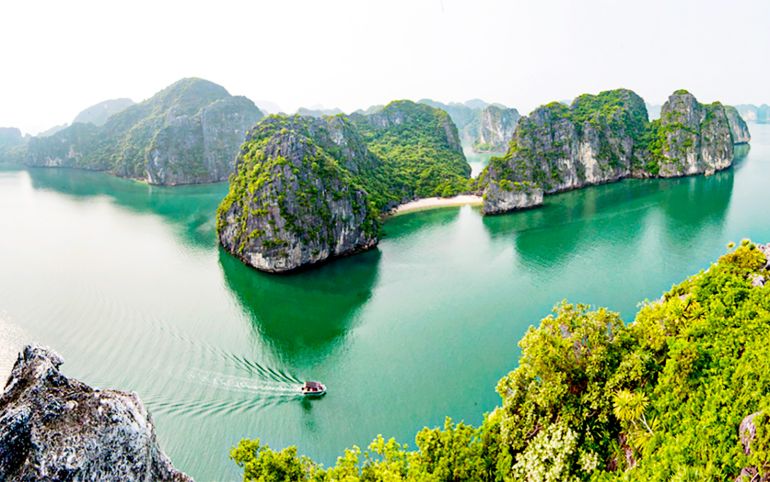Tourism - One factor propelling economic growth in coastal areas
- 162
- Business
- 18:15 04/04/2024
DNHN - The tourism industry in Vietnam is growing rapidly and has become a major driving force for the country’s economic development. Coastal areas have become attractive destinations for tourists, contributing significantly to boosting economic growth.
According to statistics, tourism revenue in 28 coastal provinces and cities in Vietnam increased from 21.9 trillion VND in 2015 to 32.9 trillion VND in 2019, accounting for 71.8% and 74.4% of the country’s total tourism revenue, respectively. The localities with the highest tourism revenue are Ho Chi Minh City, Da Nang City, Quang Ninh Province, Khanh Hoa Province and Quang Nam Province.
One of the key factors that make coastal tourism attractive to visitors is the stunning natural scenery. Vietnam has thousands of kilometres of beautiful coastline, with white sand, clear blue waters and majestic islands. Famous beaches such as Ha Long, Nha Trang, Phu Quoc and Da Nang have attracted millions of tourists from all over the world. This generates a large source of income for localities, from providing accommodation and food services to entertainment and shopping activities.

Moreover, coastal tourism also creates many job opportunities for local communities. As tourism develops, the demand for human resources in the tourism industry increases. This creates job opportunities for local people, helping to improve their living standards and reduce unemployment rates. In addition, tourism activities also promote the development of related economic sectors such as services, transportation, trade and agriculture. The development of tourism contributes to creating a strategic source of income for localities, contributing to sustainable economic development and diversifying sources of income.
In addition to the economic benefits, coastal tourism also has a positive impact on cultural development and environmental conservation. Attracting tourists to coastal areas creates conditions for the dissemination and exchange of culture between ethnic groups and nations. At the same time, sustainable tourism also prioritises environmental protection. Sustainable tourism development requires the protection and conservation of natural resources, from white sand, and mangrove forests to coral reefs and marine life. This ensures that future generations can also enjoy and explore the beauty of the coastal areas.
However, the development of coastal tourism also poses some challenges. For tourism to make a significant contribution to the economic development of coastal localities, effective and sustainable management is needed. The development of tourism infrastructure, development planning and environmental management must be carried out carefully to ensure that tourism brings long-term benefits and does not harm the environment and local communities. In addition, it is necessary to ensure that human resources in the tourism industry are professionally trained and meet the needs of tourists.
To exploit and develop coastal tourism sustainably, the Government needs to have policies to support and encourage investment in the tourism industry. Localities also need to cooperate with each other and with businesses to develop diverse and attractive tourism products. At the same time, the promotion and marketing of tourist destinations is also very important to attract domestic and foreign tourists.
In summary, coastal tourism is playing an important role in the economic development of localities in Vietnam. The combination of beautiful natural scenery, job opportunities and sustainable development is creating a strong and attractive tourism industry. However, for coastal tourism to develop sustainably, effective management and supportive policies from the government are needed, along with cooperation between localities and businesses. Only then can Vietnam’s coastal tourism continue to contribute to the country’s economic development and environmental conservation.
Nghe Nhan
Related news
- From New Year messages of World Leaders to the “new rules” of the Global economy in 2026
- Connecting Leaders, Shaping the Future: Strategic Leadership Planning Meeting – CorporateConnections Hanoi A
- Sunlight - Unilever Vietnam Recognized for Outstanding Contributions to the National Initiative Supporting Women Entrepreneurs
- Deputy Prime Minister Nguyễn Chí Dũng: “The country’s major challenges weigh heavily on my mind — and we must resolve them together.
- Unitsky String Technologies signs cooperation agreements with three Vietnamese partners, opening a new direction for smart mobility and sustainable development
- When artists do business – livelihood is no poetry!
- Before the D‑day to abolish flat‑rate tax: Fear of technology and costs leave small traders struggling to adapt
- Vietnamese enterprises at a crossroads: the impact of a potential US–China deal
- "Digital technicians" must not be forgotten if Vietnam aims to meet its strategic goals
- HDBank: Impressive profit growth, leading in profitability and advancing international integration
- TNI King Coffee sued for over VND 5 Billion in unpaid debts
- VINASME and Jeonnam Technopark Sign MOU on technology cooperation, human resource training, and trade promotion
- Vietnamese entrepreneurs strengthen ASEAN connectivity in the digital iIntegration era
- Prime Minister: Vietnam aims to become a regional logistics hub
- Vietnam upgraded to Secondary Emerging Market by FTSE Russell
- Hanoi’s economy grows 7.92% in first nine months of 2025, FDI surges nearly threefold
- Vietnam’s strong gdp growth fails to ease labor market distress
- US tariffs on Brazil propel Vietnam’s pangasius into global spotlight
- VietLeap AI Accelerator launches: A strategic springboard for Vietnam’s AI startups
- CICON expands strategic alliances: A new step forward in Vietnam–Korea business connectivity
Đọc thêm Business
From New Year messages of World Leaders to the “new rules” of the Global economy in 2026
At a pivotal moment of transition, New Year messages from capitals such as Hanoi, Beijing, Washington and Paris reflect distinct priorities and strategic visions.
Connecting Leaders, Shaping the Future: Strategic Leadership Planning Meeting – CorporateConnections Hanoi A
"Your network is your most powerful flowing asset. It generates value, multiplies opportunities, and accelerates your influence across borders."
Innovative ESG enterprise: Trạm Xe Việt startup proposes solutions to build a green mobility ecosystem
As Vietnam commits to achieving Net Zero by 2050 and tightens emissions standards, the transportation sector faces unprecedented pressure to transform.
Deputy Prime Minister Nguyễn Chí Dũng: “The country’s major challenges weigh heavily on my mind — and we must resolve them together.
On the morning of November 26, 2025, Deputy Prime Minister Nguyễn Chí Dũng chaired a high-level working session at the National Innovation Center (NIC) in Hòa Lạc.
Unitsky String Technologies signs cooperation agreements with three Vietnamese partners, opening a new direction for smart mobility and sustainable development
The signing ceremony took place in Minsk, Belarus, on November 28, 2025.
Before the D‑day to abolish flat‑rate tax: Fear of technology and costs leave small traders struggling to adapt
From 1 January 2026 the flat‑rate tax regime will be abolished. Small business households will be required to declare tax based on actual revenue. MISA supports the transition with technology to help micro‑merchants adapt smoothly and transparently.
Vietnamese enterprises at a crossroads: the impact of a potential US–China deal
As the world closely monitors every shift in US-China relations, emerging signals of a strategic agreement between the two global powers are raising hopes for global economic stability.
HDBank: Impressive profit growth, leading in profitability and advancing international integration
Ho Chi Minh City Development Joint Stock Commercial Bank (HDBank, stock code HDB) announced its consolidated profit before tax for the first 9 months of 2025 reached VND 14,803 billion, marking a 17% increase year-on-year (YoY).
TNI King Coffee sued for over VND 5 Billion in unpaid debts
On October 21, 2025, the People’s Court of District 10 in Ho Chi Minh City officially accepted a civil lawsuit concerning a commercial contract dispute between TKT Vietnam Plastic Packaging Joint Stock Company and TNI King Coffee Co., Ltd.
VINASME and Jeonnam Technopark Sign MOU on technology cooperation, human resource training, and trade promotion
On October 15, 2025, in Hanoi, VINASME and Jeonnam Technopark (Korea) signed an MOU to promote trade, advance technology transfer, and develop human resources between enterprises of both nations.











